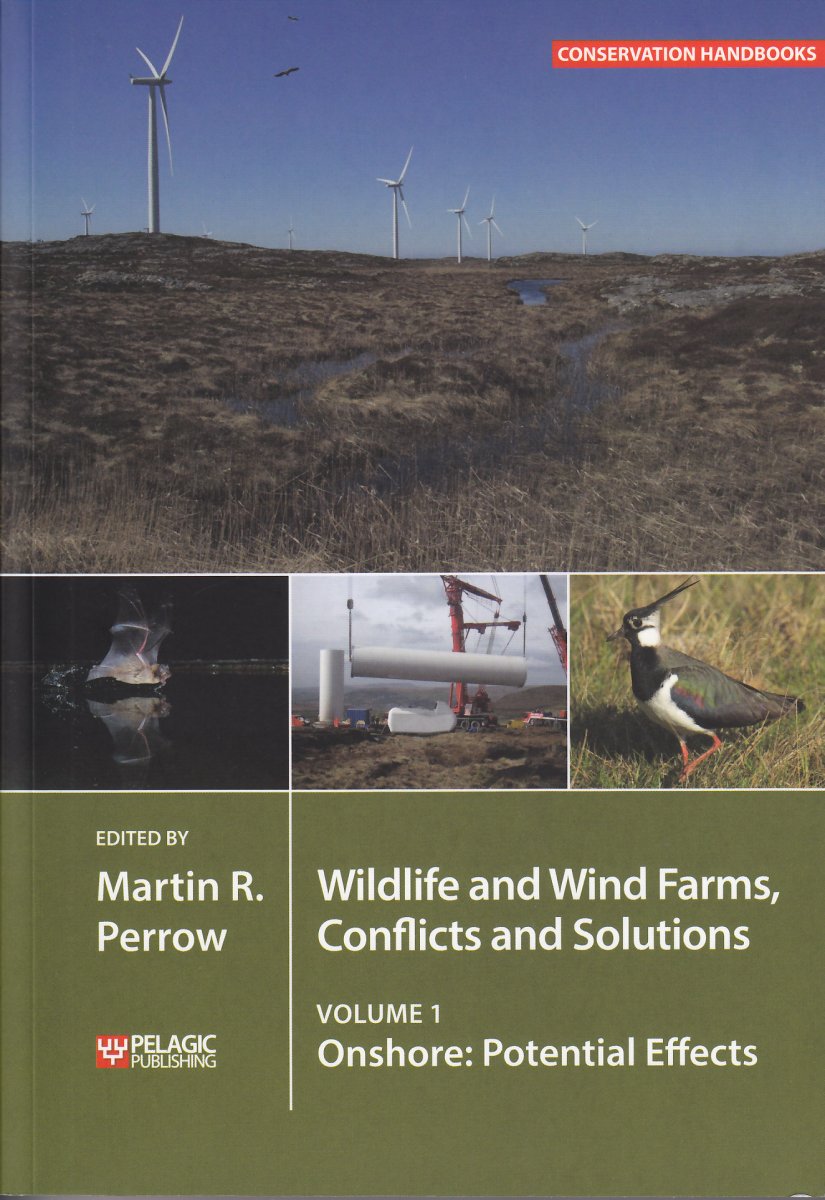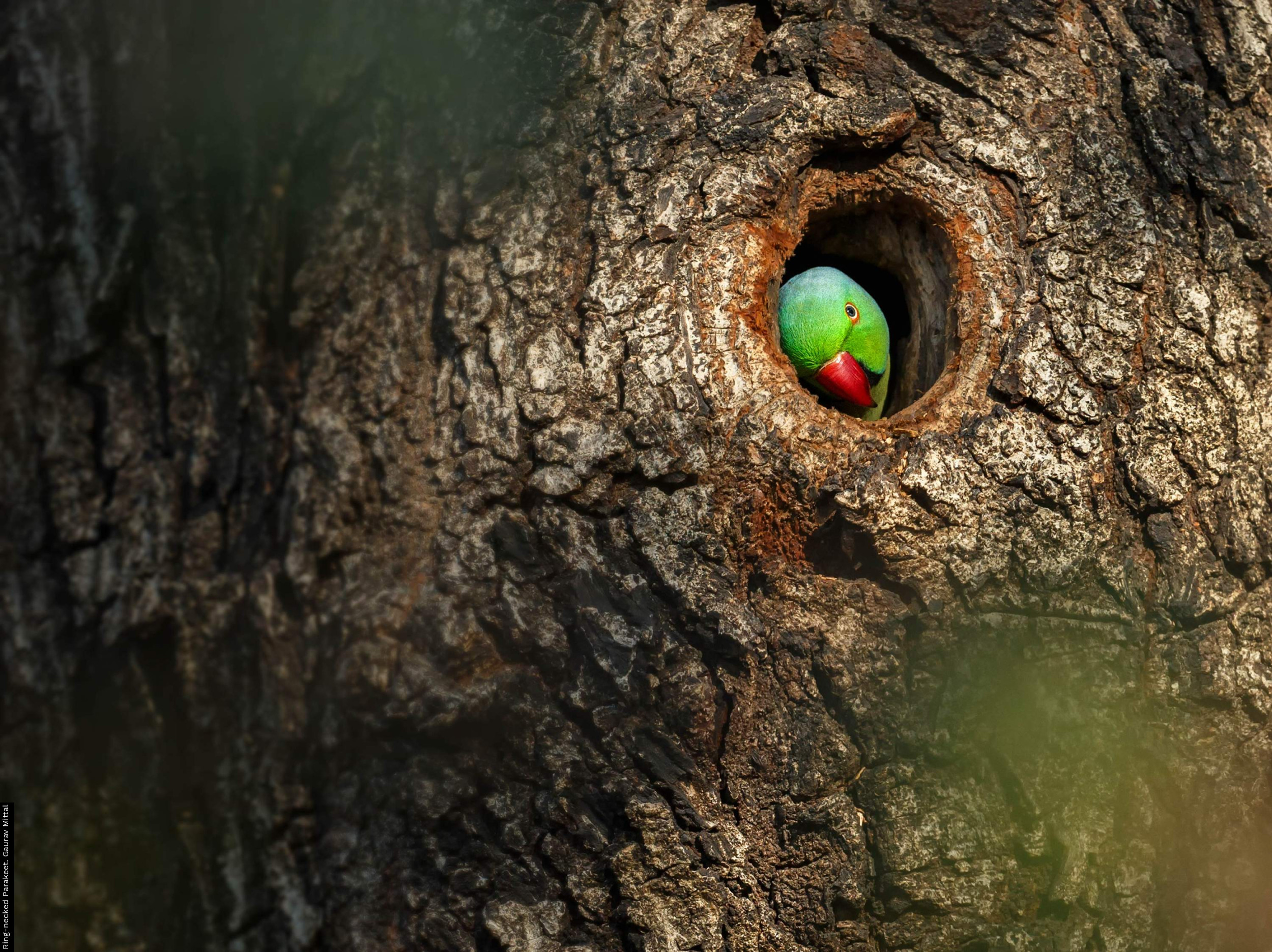
Publisher: Pelagic Publishing, Exeter
Publication Year: 2017
Binding: Softback
Page Count: 301
ISBN Number: 9781784271190
Price: £ 34.99
Wildlife and Windfarms, Conflicts and Solutions, Volume 1 Onshore: Potential Effects
Renewable energy developments such as wind farms are increasingly forming an essential part of our efforts to combat human-induced climate change. Wind farms are a well-developed and cost effective means of generating electricity (Kumar et al. 2016), likely to be used on an expanding scale worldwide. It is vital therefore to minimise any potential impacts that they could have on wildlife and biodiversity (Schuster et al. 2015). This series of books, Edited by M.R. Perrow, is a comprehensive overview of wind farm-wildlife interactions, separated into two parts, covering onshore (part one) and offshore (part two) environments. This review centres on the first onshore part, which is in turn subdivided into two separate volumes, the first (11 chapters) investigating the ‘Potential effects’ of wind farms on wildlife and habitats, and the second (nine chapters) covering the ‘Monitoring and Mitigation’ taking place so that impacts may be reduced or avoided.
After a note from the Editor, Volume 1 begins with G. Vella presenting the technological aspects of wind farms, alongside policy and planning aspects, which really brings home the expansion in wind farms that has taken place over the past decade. E.S. Takle then introduces an enlightening chapter as to the meteorological and ecosystem changes that can occur due to the presence of a wind farm. Changes in physical properties caused by turbines, such as aerodynamics, thermodynamics, and the carbon-cycle, are perhaps under-appreciated. The third chapter by M.R. Silva & I. Passos examines the potential impacts on natural vegetation communities, for which basic information was found lacking in a review of Environmental Impact Assessments (EIAs). A chapter by S. Elzay, L. Tronstad & M.E. Dillon then introduces the effects on terrestrial invertebrates, where collision potential with turbines is high, e.g. through attraction to structures, but further impact pathways such as chemical pollution, noise disturbing communication, invasive species, and food-web effects are all highlighted. The next contribution by W. O’Connor focuses on aquatic ecosystems, where despite being among the most threatened in the world (Dudgeon et al. 2006), the observed effects of wind farms are not well studied. Wind farm infrastructure and site drainage can cause physical changes to aquatic habitats, deterioration of water quality, barriers to movement, vibration, invasive species colonisation and wider-scale effects downstream. Chapter 6 by J.E. Lovich and J.R. Ennen shifts the focus to reptiles and amphibians. The reliance on only two published outputs is testament to the lack of research on herpetofauna; some potential impacts are shared with other taxa, but further include electromagnetic fields and heat from buried transmission lines and fire risk.
The book then introduces us to the effects of wind farms on birds. This topic is split across two chapters (7 and 8), covering the main effects of displacement due to disturbance by H. Hotker, and collision risk by M. De Lucas and M.R. Perrow. An extensive literature review is presented for disturbance, the mechanisms for which are still poorly understood, identifying some species groups that may be more displaced than others. Collision is a major topic for airborne birds (Chapter 8) and bats (Chapter 9). M. De Lucas and M.R. Perrow go on to discuss how avian collision rates, as observed fatalities, may vary greatly depending for example on habitat, location, turbine types, but with an emerging consensus that birds of prey are generally more prone to collision than some other species, a pattern also found in a recent meta-analysis published shortly after this book (Thaxter et al. 2017). The variation in bat fatalities, and differences to birds, are among key subjects discussed next by R.M.R. Barclay et al., where estimates of total bat fatalities may range up to millions killed per annum, from either direct collision, or changes in air pressure causing internal injuries. Finally, J.O. Helldin et al. present a chapter on terrestrial mammals, for which few published studies were found. Removal of habitat is a key concern, and avoidance of wind farms and infrastructure has been found in large carnivores and ungulates. Positive effects, however, may also arise; for example, providing corridors for movement or additional habitat and prey. The volume concludes with a synthesis by M.R. Perrow setting the scene for volume 2. The authors of the individual chapters raise several priority research areas, many of which chime across the volume. Two in particular are reflected nicely in this final chapter, ‘in-combination and cumulative effects’, and ‘impacts upon populations’. An inescapable matter, however, is the mismatch of scientific study that has been carried out for birds and bats versus other taxonomic groups.
Volume 2 opens with chapters on monitoring birds from K.S. Smallwood and bats by C.D. Hein. Both touch on similar themes, and chapter 1 includes a nice overview of EIA baseline studies. Pre- and post-construction survey methods in both chapters range from visual methods such as scans, nest counts (birds), roost surveys (bats), to the use of radar, telemetry, acoustics and infra-red imaging. As highlighted, biases in estimating area use pre-construction make it difficult to compare data to post-construction surveys, such as fatality monitoring. A combination of survey methods, targeted research questions and survey designs are highlighted as best practice. Birds and bats are re-united in the third chapter, that details collision risk modelling to assess potential effects on species prior to construction. Six main modelling frameworks are discussed as are the many factors that may influence the probability of collision.
The methods used to attempt to translate collision predictions to a population context are clearly laid out. However, as acknowledged, the verification of modelled collision rates alongside observed fatalities once wind farms have been built has rarely been undertaken. Such fatalities are never perfectly known from surveys, and therefore require their own estimators to be applied, accounting for aspects that may influence the detection probability of victims, such as scavenger removal, survey design, searcher intervals and observer efficiency. These elements are extensively covered in the next chapter by M. Huso et al. who set out the corrections and statistical modelling procedures that need to be applied. Determining the sensitivity of species to wind farm impacts is important prior to construction and can also inform spatial planning at wider scales. Sensitivity mapping is a useful tool in this regard, and the next chapter by J. Bright and C. Muldoon outlines their usefulness for decision-makers, developers and consultants, to avoid potential impacts on protected sites designated for important species and habitats.
The volume then turns to mitigation of impacts of wind farms, with a very palatable overview from R. May outlining the prioritised hierarchical mitigation steps along the development process, such as siting of wind farms, eco-friendly planning and design and operational adjustments to minimise risk. The following two chapters (7 and 8) then provide examples of these mitigation strategies for birds, by K.S. Smallwood et al. and bats by E.B. Arnett which, although covering some similar ground, enhance the work undertaken and include some excellent case studies. The communication between scientific researchers and planners/developers is mentioned, which is an important point to make, being also the subject of a discussion panel at the most recent conference of the Conference on Wind Energy and Wildlife Impacts, in Estoril, Portugal in September 2017. This second volume concludes with a chapter on the best practice approach to future planning by Gartman et al., which summarises an 11-point strategy providing guidance going forward.
These two books are a major step forward consolidating our current knowledge of potential impacts of wind farms on wildlife, and options for monitoring and mitigation. Coherent structures for each chapter provide easy navigation, and liberal decoration with case studies, figures, tables and photographs, means that the expansive content is easily digestible. A minor quibble may be that volume 2 focuses almost entirely on birds and bats, after laying some important groundwork for other under-studied taxa in volume 1; as acknowledged, this reflects where most focus has been directed. The call for greater study on population-level monitoring and cumulative effects echoes those of other recent reviews, such as the publication of presentations from the Conference on Wind Energy and Wildlife Impacts held in Berlin in 2015 (Köppel 2017), which are among the most challenging of aspects to study but are essential to consider. The Editor and the many authors of chapters and cases studies should be congratulated on this important contribution to the field. The next two offshore volumes are highly anticipated.
Dudgeon, D., Arthington, A.H., Gessner, M.O., Kawabata, X.-I., Knowler, D.J., Lévêque, C., Naiman, R.J., Prieur-Richard, A.-H., Soto, D., Stiassny, M.L.J. & Sullivan, C.A. 2006. Freshwater biodiversity: importance, threats, status and conservation challenges. Biological Reviews 81: 163–182.
Kumar, Y., Ringenberg, J., Depuru, S.S., Devabhaktuni, V.K., Lee, J.W., Nikolaidis, E., Andersen, B., Afjeh, A. 2016. Wind energy: trends and enabling technologies. Renew. Sustain. Energy Rev. 53, 209–224.
Köppel, J. (ed) 2017. Wind Energy and Wildlife Interactions: Presentations from the CWW2015 Conference. Springer International Publishing AG, 289 pp.
Schuster, E., Bulling, L. & Köppel, J. 2015. Consolidating the State of Knowledge: A Synoptical Review of Wind Energy’s Wildlife Effects. Environ. Manage. 56: 300–331.
Thaxter, C.B., Buchanan, G.M., Carr, J., Butchart, S.H.M., Newbold, T., Green, R.E., Tobias, J.A., Foden, W.B., O’Brien, S. & Pearce-Higgins, J.W. 2017. Bird and bat species’ global vulnerability to collision mortality at wind farms revealed through a trait-based assessment. Proceedings of the Royal Society B 284: 20170829.
Book reviewed by Chris Thaxter






Share this page